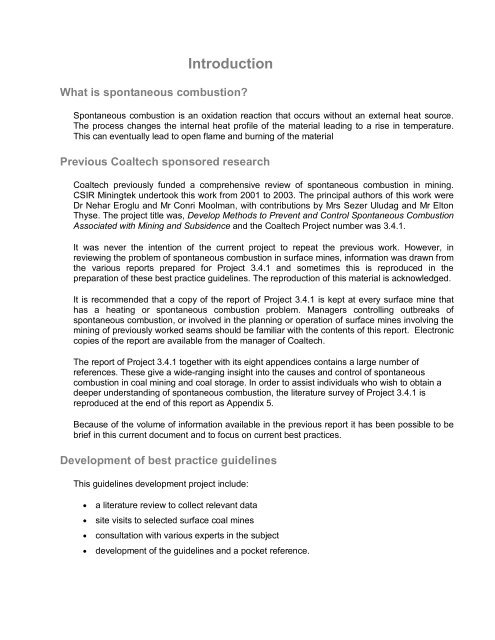prevention and control of spontaneous combustion - Mining and
prevention and control of spontaneous combustion - Mining and
prevention and control of spontaneous combustion - Mining and
You also want an ePaper? Increase the reach of your titles
YUMPU automatically turns print PDFs into web optimized ePapers that Google loves.
Introduction<br />
What is <strong>spontaneous</strong> <strong>combustion</strong>?<br />
Spontaneous <strong>combustion</strong> is an oxidation reaction that occurs without an external heat source.<br />
The process changes the internal heat pr<strong>of</strong>ile <strong>of</strong> the material leading to a rise in temperature.<br />
This can eventually lead to open flame <strong>and</strong> burning <strong>of</strong> the material<br />
Previous Coaltech sponsored research<br />
Coaltech previously funded a comprehensive review <strong>of</strong> <strong>spontaneous</strong> <strong>combustion</strong> in mining.<br />
CSIR <strong>Mining</strong>tek undertook this work from 2001 to 2003. The principal authors <strong>of</strong> this work were<br />
Dr Nehar Eroglu <strong>and</strong> Mr Conri Moolman, with contributions by Mrs Sezer Uludag <strong>and</strong> Mr Elton<br />
Thyse. The project title was, Develop Methods to Prevent <strong>and</strong> Control Spontaneous Combustion<br />
Associated with <strong>Mining</strong> <strong>and</strong> Subsidence <strong>and</strong> the Coaltech Project number was 3.4.1.<br />
It was never the intention <strong>of</strong> the current project to repeat the previous work. However, in<br />
reviewing the problem <strong>of</strong> <strong>spontaneous</strong> <strong>combustion</strong> in surface mines, information was drawn from<br />
the various reports prepared for Project 3.4.1 <strong>and</strong> sometimes this is reproduced in the<br />
preparation <strong>of</strong> these best practice guidelines. The reproduction <strong>of</strong> this material is acknowledged.<br />
It is recommended that a copy <strong>of</strong> the report <strong>of</strong> Project 3.4.1 is kept at every surface mine that<br />
has a heating or <strong>spontaneous</strong> <strong>combustion</strong> problem. Managers <strong>control</strong>ling outbreaks <strong>of</strong><br />
<strong>spontaneous</strong> <strong>combustion</strong>, or involved in the planning or operation <strong>of</strong> surface mines involving the<br />
mining <strong>of</strong> previously worked seams should be familiar with the contents <strong>of</strong> this report. Electronic<br />
copies <strong>of</strong> the report are available from the manager <strong>of</strong> Coaltech.<br />
The report <strong>of</strong> Project 3.4.1 together with its eight appendices contains a large number <strong>of</strong><br />
references. These give a wide-ranging insight into the causes <strong>and</strong> <strong>control</strong> <strong>of</strong> <strong>spontaneous</strong><br />
<strong>combustion</strong> in coal mining <strong>and</strong> coal storage. In order to assist individuals who wish to obtain a<br />
deeper underst<strong>and</strong>ing <strong>of</strong> <strong>spontaneous</strong> <strong>combustion</strong>, the literature survey <strong>of</strong> Project 3.4.1 is<br />
reproduced at the end <strong>of</strong> this report as Appendix 5.<br />
Because <strong>of</strong> the volume <strong>of</strong> information available in the previous report it has been possible to be<br />
brief in this current document <strong>and</strong> to focus on current best practices.<br />
Development <strong>of</strong> best practice guidelines<br />
This guidelines development project include:<br />
• a literature review to collect relevant data<br />
• site visits to selected surface coal mines<br />
• consultation with various experts in the subject<br />
• development <strong>of</strong> the guidelines <strong>and</strong> a pocket reference.

















